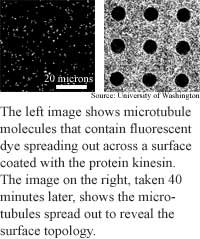
Cell
parts paint picture
By
Chhavi Sachdev,
Technology Research NewsProbes that go to the depths of Earth's oceans and to planets like Mars beam back information about the topography and geography of places we can't visit in person. Researchers at the University of Washington have come up with probes hundreds of times smaller than a blood cell that can explore the nooks and crannies of objects so small they are difficult to image.
The probes, made from a pair of biological materials that form networks in living cells, provide higher-resolution images than conventional scanning microscopes, according to Henry Hess, a research assistant professor of bioengineering at the University of Washington.
In cells, the protein kinesin travels on microtubule conveyor belts to regularly shunt biological loads like chromosomes and vesicles from the center of a cell to its edge. Vesicles carry waste materials.
Scientists have already tapped microtubules and motor proteins to transport tiny payloads. To use them as probes, however, the researchers reversed the proteins' roles, unleashing a horde of about 600 microtubules on a kinesin-coated surface. The microtubules, doped with a fluorescent substance that makes them easy to image, propelled themselves over the kinesin to map out terrain. Each microtubule is 1,500 nanometers long and 24 nanometers in diameter, or about three thousand times narrower than a human hair.
The microtubules travel in straight lines and they can easily cross over each other, said Hess. One key to their utility, however, is in a limitation -- the proteins cannot go everywhere. They can descend into troughs on the surface, but their structure prevents them from bending enough to climb peaks. Where there are little hillocks, or bumps, the microtubules cannot tread. Bald spots on microtubule maps, therefore, correlate to bumps on the terrain.
Conventional probe microscopes gain topographical information by scanning a surface with a tiny tip. Narrow cavities in cells or MEMS devices, however, are difficult for scanning tunneling and atomic force microscopes to access. These could be characterized by the protein probes, said Hess.
Instead of scanning a fine tip along straight lines, the researchers' probes are like "hundreds of critters running across the surface [sending] you very simple information, which you integrate to get a complete picture," he said.
"Imagine an ant crawling across a surface," said Hess. A single ant moves randomly across a surface and covers only a small area. If there are hundreds of ants crawling around, however, "nothing on the surface will escape their attention," he said. "If there is a puddle, the ants will not go in there, so all the paths will go around the puddle."
A time-lapse recording of all ant movement would show an accurate picture of where the ants went as well as what areas they avoided, like the puddle. "In our case the ant is a microtubule [moving] across a surface coated with kinesin," said Hess.
The crisscrossing microtubules travel at 250 nanometers per second and are imaged every 5 seconds. The composite view becomes more detailed with time and a complete picture emerges after about 40 minutes. The researchers found the best image when they used every other frame, comparing the position of the microtubules every ten seconds. "The microtubules need at least 6 seconds to get to a completely new spot, otherwise the tail [of the protein] is where the tip has been before," said Hess.
Microtubules could also be used to image biological or radioactive contamination, "which you donít want to touch with a tip," said Hess. They could be made to sense more specific details, such as the magnetism of a surface or its pH level, by coating it with, for instance, a pH sensitive dye, according to Hess.
They next plan to make the microtubules maps more detailed, including information on the height of the hillocks, said Hess.
Hess's research colleagues were John Clemmens, Jonathon Howard, and Viola Vogel. They published the research in the February 13, 2001 issue of the journal Nano Letters. The research was funded by NASA.
Timeline: 5 years<
Funding: Government
TRN Categories: Biotechnology; Materials Science and Engineering; Data Acquisition
Story Type: News
Related Elements: Technical paper, "Surface Imaging by Self-Propelled Nanoscale Probes," Nano Letters, February 13, 2002.
Advertisements:
July 10/17, 2002
Page One
Photons heft more data
Eavesdropping gets people talking
Self-learning eases quantum programming
Conceptual links trump hyperlinks
Cell parts paint picture

News:
Research News Roundup
Research Watch blog
Features:
View from the High Ground Q&A
How It Works
RSS Feeds:
News
Ad links:
Buy an ad link
| Advertisements:
|
 |
Ad links: Clear History
Buy an ad link
|
TRN
Newswire and Headline Feeds for Web sites
|
© Copyright Technology Research News, LLC 2000-2006. All rights reserved.